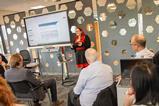
Need to know:
- A diversity, equity and inclusion (DE&I) framework should start by looking at the organisation’s overall mission and identifying its key objectives.
- It can assess how any initiatives and benefits schemes it offers can best support the framework.
- A DE&I framework should be reflected in all areas of an employer’s people strategy.
With the momentous changes to working life that the Covid-19 (Coronavirus) pandemic has brought, so too has it increased the focus on diversity, equity and inclusion (DE&I) in the workplace. Organisations have proven that flexible working is effective; the government recently announced plans to make flexible working requests a day-one right for all employees. Increasing numbers of organisations are reporting their pay gaps; not just gender disparity but also ethnicity and disability differences.
However there are also reports of how few employers have a strategic plan in place to address DE&I in their organisation; in a September 2021 survey of small and medium-sized enterprises (SMEs) directors and managers by GetApp, 51% said their organisation still has significant work to do to improve diversity and inclusion. And a poll of its conference attendees in May 2021 by pension consultant Barnett Waddingham found that 75% do not yet have a formal DE&I framework in place. What steps can employers take to create a formal DE&I framework?
Key objectives
The best starting point is to look at the organisation’s overall mission for DE&I and how it can pinpoint its key objectives. Louise Weston, partner at Pearn Kandola, says that employers need to understand how DE&I fits into their wider organisational strategy. “Whatever [the] organisational goals are, think about how DE&I aligns and fits with that,” she says. “For example, if one of the ways in which [an employer] wants the business to grow is going to be through innovation, we know that diversity is really critical for innovation; so [it] wants to be able to align [its] DE&I strategy with the organisational strategy.”
From this point, an employer can ascertain what its key DE&I objectives are and then consider the timeframe to achieving these goals. “Often I see objectives starting with, ‘what do we want immediately accomplished’, maybe in a one and then a three-year time frame,” explains Leah Johnson, vice president, advisory at Gartner. “I don't see a lot of organisations that are putting together a DE&I strategy that looks much further than a three-year time horizon, just because things are changing so rapidly and we want to make sure that the strategies are relevant.”
To further inform the framework, an employer should ensure that it has gathered key data on its organisation to help pinpoint the areas to focus on. “Organisations should identify what the key priorities are for them around DE&I and be able to address them,” says Weston. “It might be that they are linked to the organisational goals, or that it has data that can inform the strategy that it is developing. But [employers] need some data to drive what it is doing or where it wants to focus.”
Data on the composition of a workforce is essential for the creation of a DE&I framework. Dr Avneet Kaur, principal consultant, health solutions Emea, at Aon, explains that employers should start with identifying what the demographics of an organisation look like, and then assess how benefits can support each individual group. “Benefits are actually the way to support the diverse needs of a population,” she says. “All the different elements of diversity, equity and inclusion can be boiled down to individual needs, and individual health and wellbeing needs. That is where the benefit angle comes into play.”
Initiatives to support DE&I strategy
The next viable step in creating a framework is to view which initiatives and benefits can help to support it. Employers must firstly assess what they already have in place, in order to determine the starting point. “That current state assessment is really important to say, ‘this is our starting line, this is what we're going to be looking to accomplish in the short term, this in the long term, these are the initiatives that are going to be getting us there’,” says Johnson. For example, Johnson suggests, if an objective is that the organisation is losing too many women, the current state assessment would look into the reasons why women are leaving or what the difficulty is in attracting them. Looking at how DE&I can be weaved into the employment deal is another critical part of building the framework. “What [employers] are really starting to understand and value more than ever, is the much more holistic approach and an inclusive environment,” says Sarah Lardner, director of business innovation at Innecto. “Then they start to hire more diverse talent, and it actually brings a much more holistic approach around innovation, idea generation, values and perceptions. It has a return on investment for the business: it increases productivity, reduces employee turnover and really does help attrition, because there is that sense of purpose.”
Woven into the framework, reward and benefits can help to promote an employer’s DE&I approach. Pay equity and transparency is one example of this, says Lardner. But how far should employers go in sharing pay strategy information in the name of equity? “Some organisations really feel that in being completely transparent, almost sharing all salary information to all employees, while it can feel a bit turbulent to start with actually there's less noise about it because it's all out on the table and employees respect that,” Lardner says. “While it's not right for everybody, what we see a lot of is that they want transparency. But it's not about publishing salaries; it's about the transparency of the process and methodology, so that it reassures and builds confidence that pay is being managed robustly with consideration and therefore mitigating against any bias.”
An employer’s healthcare and wellbeing provision also provides opportunity to demonstrate its DE&I approach, but it has to place careful consideration around the composition of its workforce, and what the best type of support may be. Mental health and wellbeing are a high priority post-Covid, but different groups within organisations will have been impacted differently, says Weston. “Minority groups or marginalised groups in organisations may have been hit much harder, both from a physical standpoint from Covid, but also from an emotional standpoint. For example, if I'm a black employee, I'm statistically more likely to have had Covid and to have had friends and family who have been impacted as well. We know that discrimination can have an impact on health and wellbeing; it is not just overt racism or overt homophobia, but the small stuff like micro-incivility and micro-behaviours. We know that they have a really significant impact on the health and wellbeing of minority groups in organisations.”
Employers should factor in initiatives that can be tailored to individual’s need with the right kind of support structures and resources that can offer specialist experience.
It is important to remember that a DE&I framework needs to be a core element of an organisation’s overall purpose and vision in order to achieve its objectives. “It should get reflected everywhere,” says Kaur. “It should get reflected in hiring, in promotion, benefits, communication; everywhere.”

































